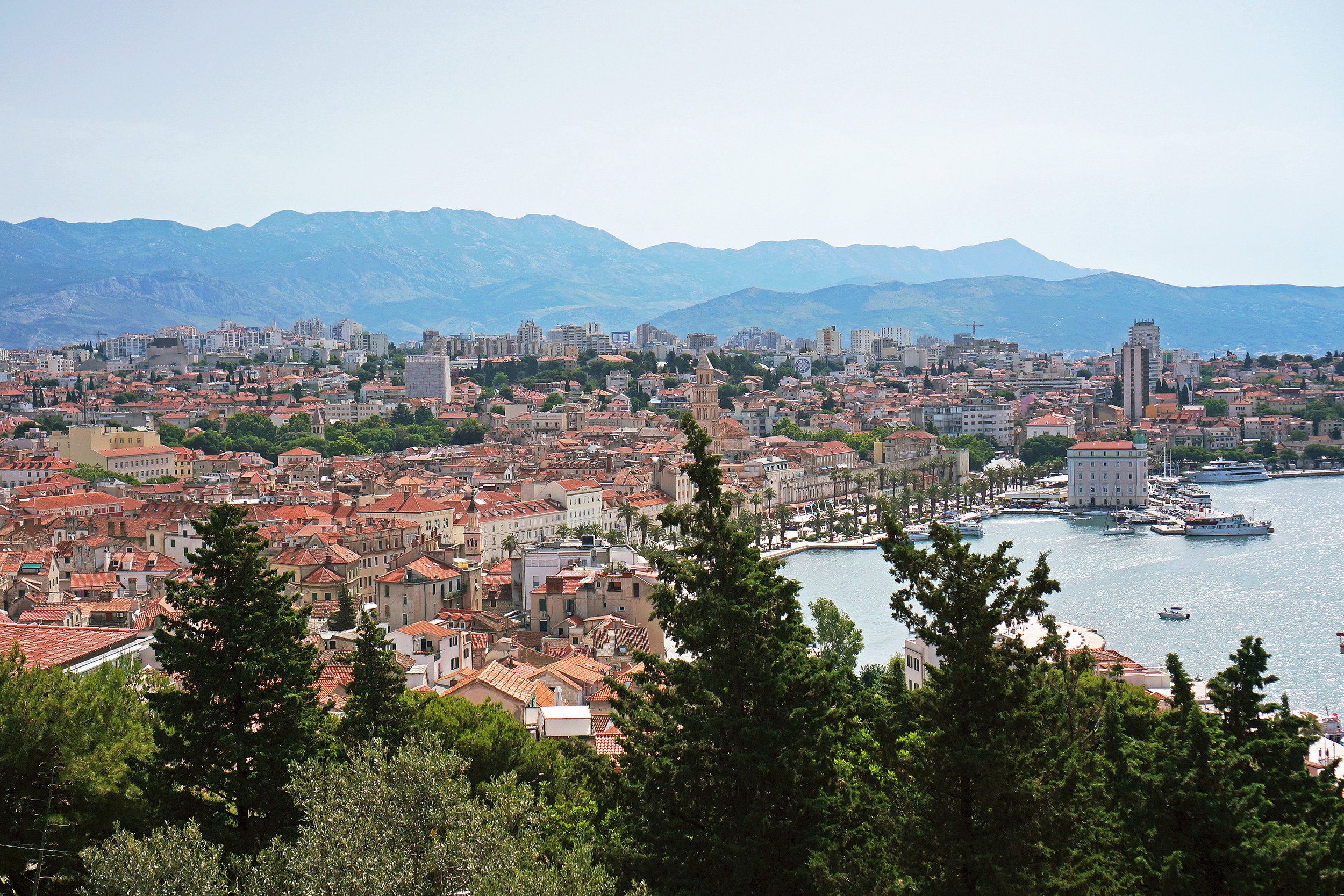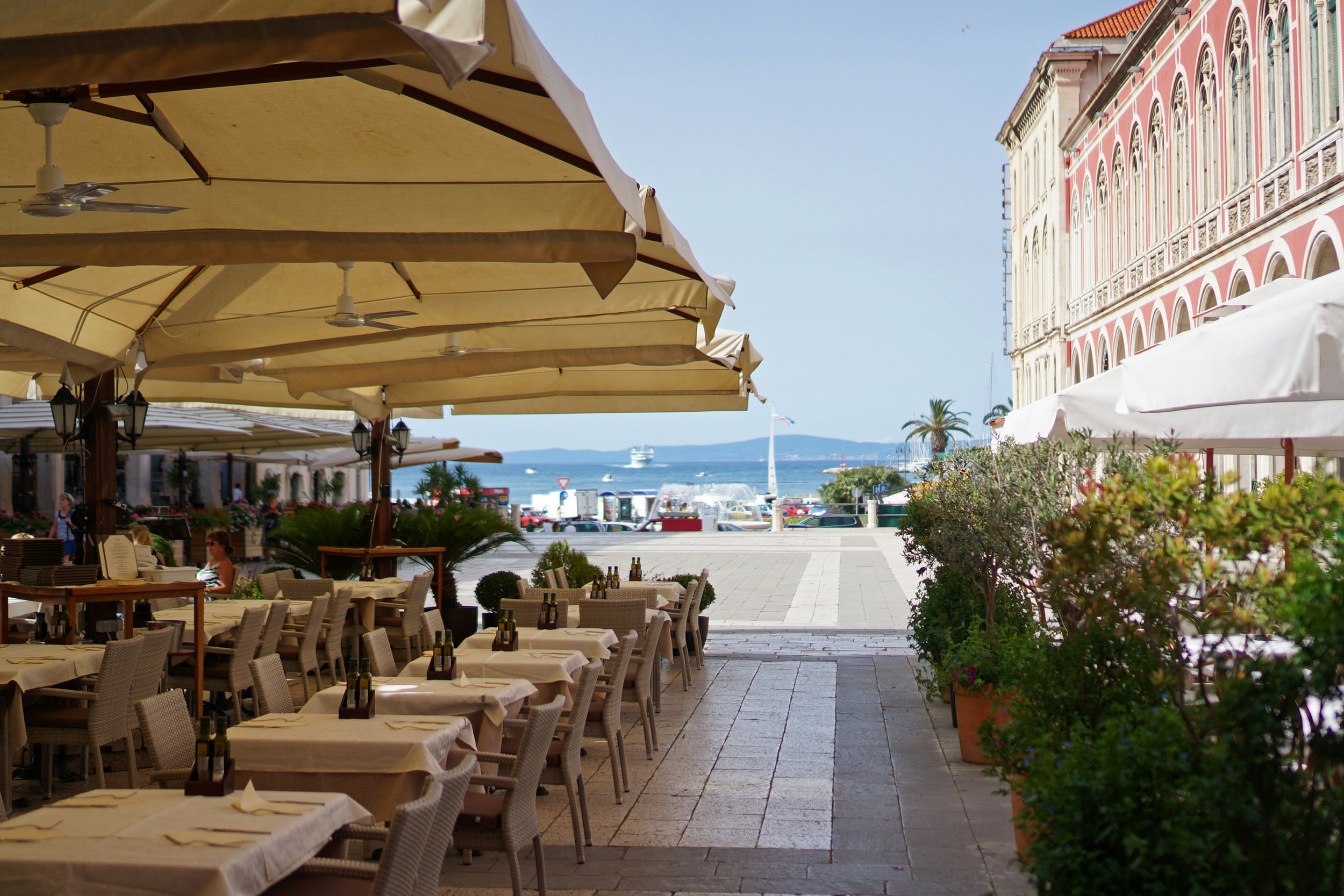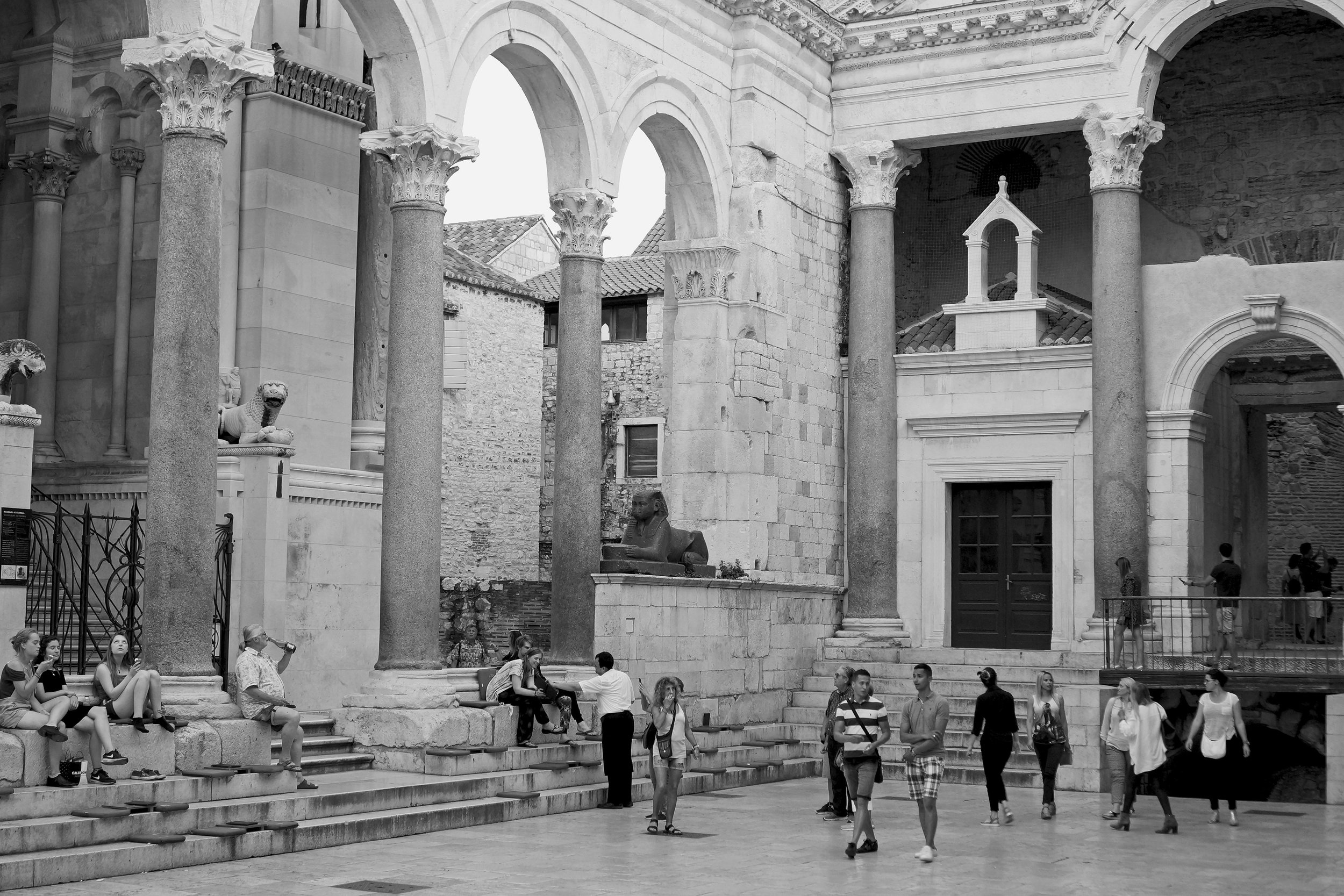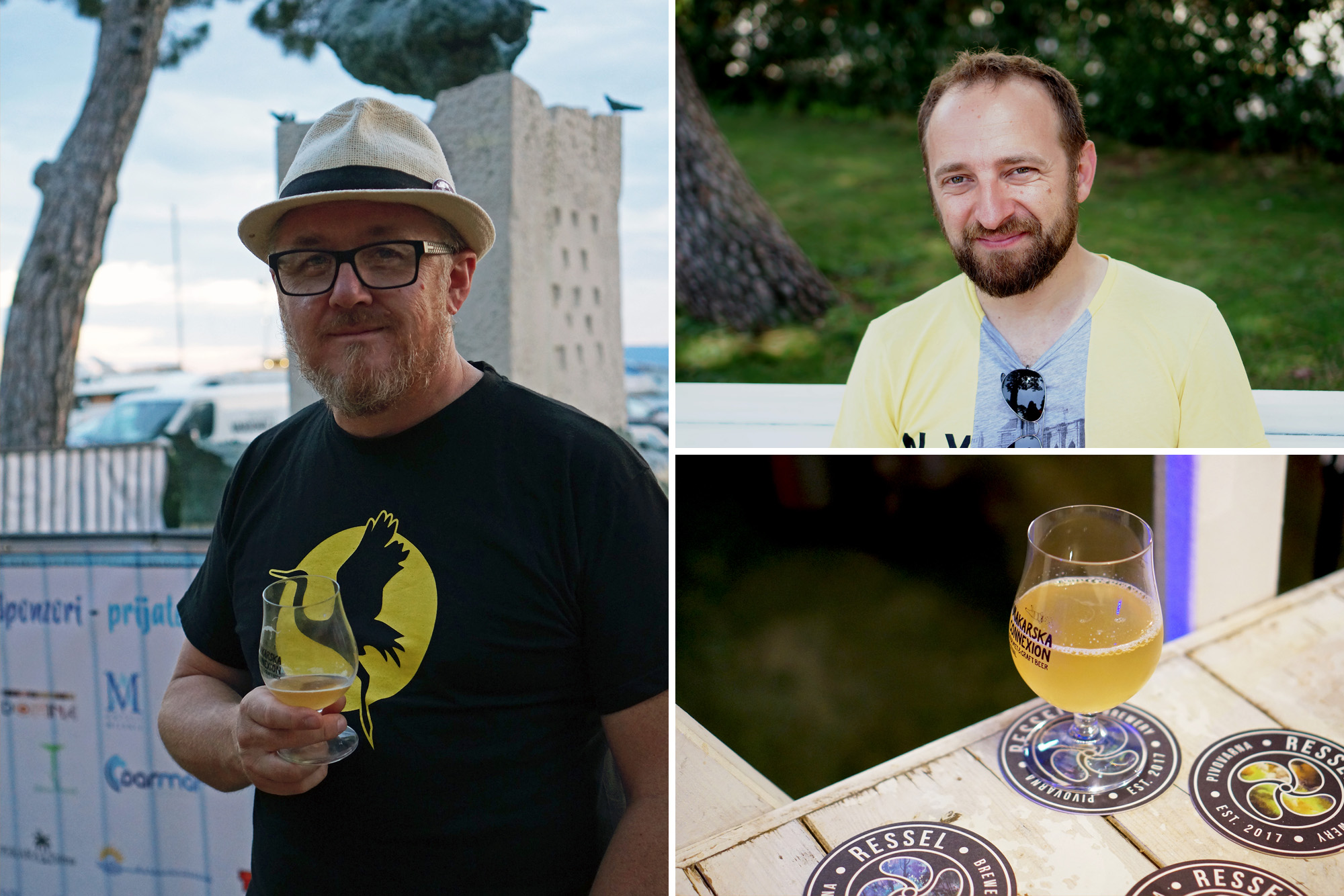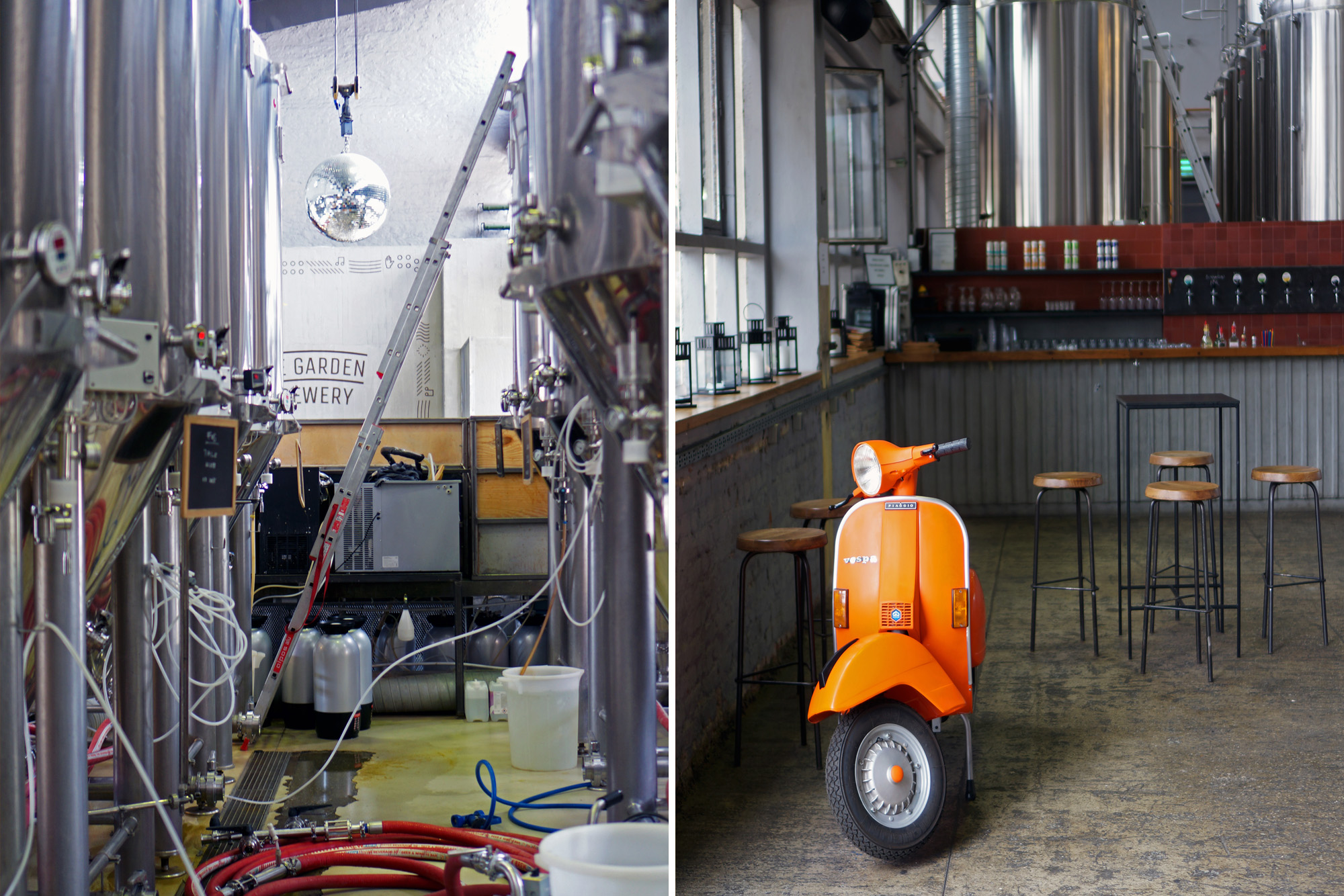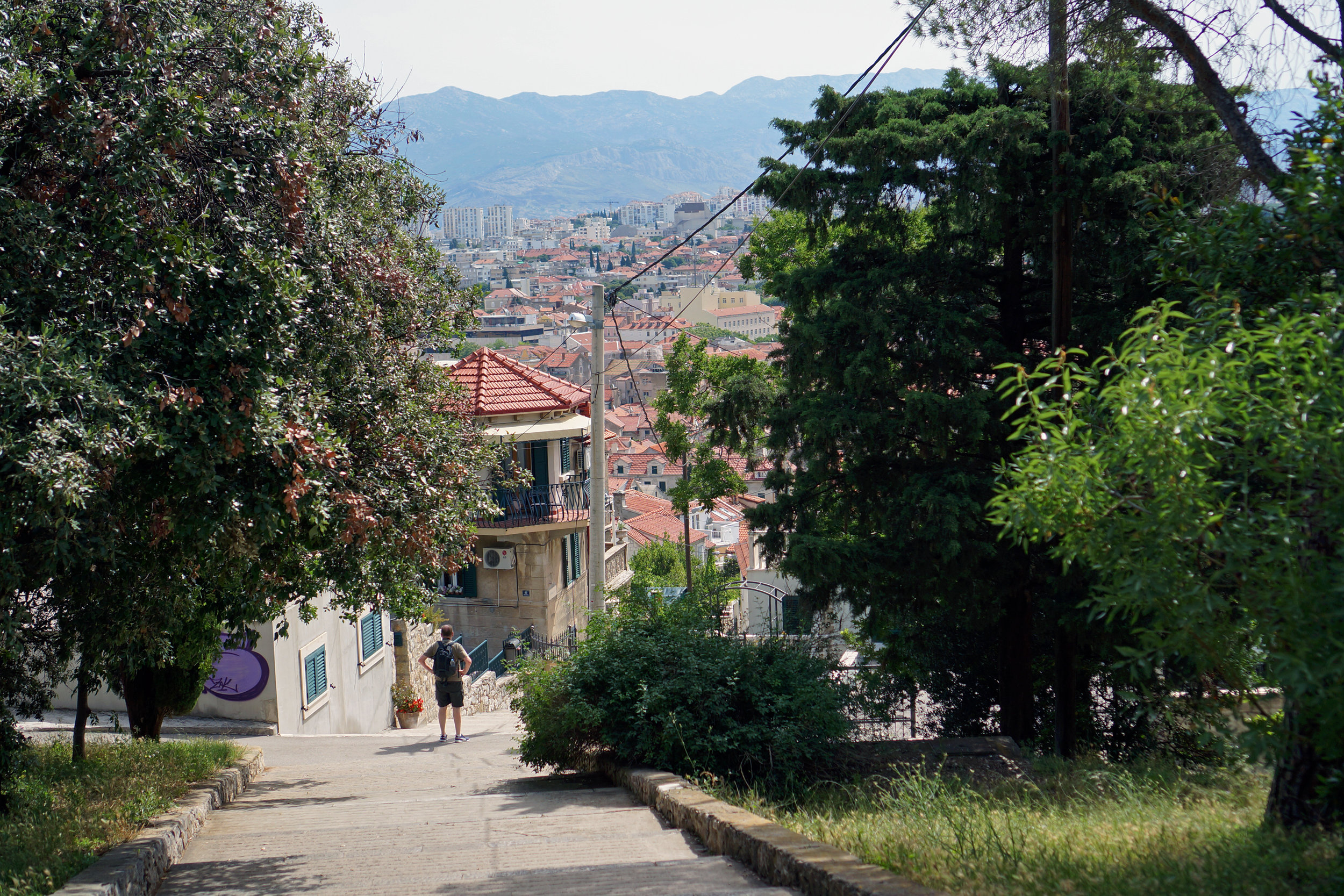Some cities have soundtracks and others have scents. Paris smells like cigarettes mixed with scooter exhaust. London mostly reeks of pollution, barring unexpected wafts of jasmine or rose. The first thing you should know about Split—Croatia’s second-largest city—is that it smells, biblically, of fig trees.
I notice it just minutes after stepping off the airport bus. To get to my guesthouse, I have to drag my bag from the waterfront up the signless alleys of the Veli Varoš neighborhood, just west of the city center. Amidst its picturesque crumble, the city is lawlessly lush, and it isn’t only the figs. Ivy gets bored of walls and moves onto telephone wires. Churches’ roofs sprout flowers. Each house has its prelapsarian garden, heavy with grapes and olives.
The city’s first impression is one of Edenic bounty: here is a place that can provide whatever is required to make a body feel good. In the evening I head to a local bar, where a bartender tells me about the cherry trees at his grandmother’s house, and the rakija brandy that she makes with them, before offering me a bump of cocaine. The only other people inside are two Americans who have traded Florida for Croatia, and who are leaning toward Barcelona next.
It’s only the beginning of the high season when I visit, not yet summer, and Split could be a house party in its earliest stages: perfectly decorated but tensed, waiting for the crowds to rush in. On my way back to my bed, I walk past garishly lit bars, small huddles of students smoking out front. The music follows me up the hill, as does the suggestive musk of those fig leaves.
It’s no mystery why tourists like me seek out Split. Its sun is copious, its landmarks postcard-ready, its location on the coast ideal for island hopping. The city’s gravitational heart is Diocletian’s Palace, built for the eponymous Roman emperor in the 4th century AD. Unlike Rome’s Forum or Athens’ Parthenon, Diocletian’s Palace is lived-in rather than kept at arm’s length. It lacks a roof and, on some sides, closed-off walls, which means it operates in the opposite way of most palaces: I keep winding up inside it by mistake. Its marble floors have been walked on by so many feet that they’re as smooth and slippery as a freshly drained bathtub.
The image is appropriate because, like most places in the business of pleasure, Split is also slick. Diocletian’s Palace may have its ancient colonnades, but they share space with the identikit bars and souvenir shops that colonize the heart of every major European city. Costumed gladiators patrol the North Gate. Just beyond is the white crescent of the Riva promenade, where sun-kissed kids filter on and off party boats. Eden aside, the city is also manicured, neatly packaged.
By some kink in the way that travel trends are cooked up and propagated across year-end round-ups, Croatia became a Next Hot Destination a handful of years ago. Chalk it up to Game of Thrones, which turned the country into a film set, or to Croatia’s accession to the European Union in 2013. At a squint, it could resemble Italy—its neighbor across the sea—without the corresponding prices. The specter of the Yugoslav Wars has long since blown off, and low-cost carriers keep adding new routes.
Croatia is small, if you operate according to an American sense of scale, roughly the size of West Virginia, with a population of just 4.2 million. Its coastline, however, is inordinately long—long enough to make memes about. From the air, the country is first recognizable for its green islands, the filaments of their beaches still visible at 30,000 feet. The land is karst. The Adriatic Sea is a star-bright wine. Last year, a record-breaking 19.7 million people came to see it for themselves—almost five tourists for every resident, and 13% more than the year before.
Is there beer in paradise? If the billboards are to be believed, yes, but mostly in glass bottles, and it’s not usually worth thinking too much about. Croatia reportedly drinks 10 bottles of Ožujsko Pivo—the country’s most popular beer, owned by Molson Coors—every second. It’s refreshing, cheap, and goes well with a beach.
Independent breweries are harder to find, particularly on the Dalmation coast. On my second day in Split, I visit Mandrill Nano-Brewing: one of three craft breweries in this city of roughly 178,000 people, alongside Tap B Craft Brewery and LAB Brewing. When I meet him, owner Leo Maleš is affable and enthusiastic, despite the fact that he’s covered in a sheen of sweat and that, inside his brewery, it’s close to 90 degrees. He shows me the modest kit he uses to make beers like his California Common and Hefeweizen. It occupies a tight nook next to the bar, and tending to it is sweltering work.
Mandrill has been open for just a few months when I visit, but it’s not Maleš’ only local venture. In 2015 he founded Leopold's Delicatessen Bar, the city’s leading craft-beer bar. His family has worked for generations in hospitality, and opening Leopold’s, however groundbreaking, felt natural to him, even predestined. When Maleš steps out of earshot, an employee describes him as a prolific mentor to would-be brewers, a hopelessly generous person. As if to prove it, he invites me to partake in the brewery’s lunch spread of bread and cheese and red-pepper paste.
Before he was a professional, Maleš was a homebrewer. It’s a common occurrence in Croatia: if mainstream beer options have historically been limited, the country has made up for it with a long-simmering homebrewing scene. In fact, all three of Split’s breweries grew out of the same homebrewing club.
Today, the breweries go in together on shipments of Slovenian hops and pallets of Simpsons Malt and other essential supplies. Joining forces has become a way of surviving in an environment that has often been hostile to burgeoning entrepreneurship. The brewers I talk to cite everything from depressed wages, low consumer knowledge, and uninterested bar owners to high taxes, confusing bureaucracy, and government corruption as factors that have made opening a brewery in Croatia a particularly gnarly proposition.
It might be fairer to say that Split has two and a half breweries when I visit. At the time, Tap B is technically 11 days from opening. It is headquartered in a long-empty restaurant premises some distance east of the city center, hidden amongst dusty, sun-bleached housing blocks. I watch workers lay panes of glass shelving while co-founder Hrvoje Paštar pours me a glass of Trapula APA directly from the tank.
Although LAB Brewing occupies a more traditional industrial estate in northern Split, a neighboring company happens to be spit-roasting an entire cow in the parking lot when I visit later that afternoon.
LAB’s co-founder, Siniša Anđelić, is also the organizer of Split’s homebrewing club. He remembers first coming across homebrew years ago, while living in Norway. The idea of homemade beer was at first strange to him, even repulsive, but a sip of his friend’s beer changed his mind. Upon returning to Split, he helped shepherd the scene into being.
“When American breweries faced the big ones 20 years ago, the big ones learned something. This is very bad for us, because they learned how to fight against the small ones now.”
LAB is now one of Croatia’s best-known craft breweries, and Anđelić counts industry figures like former New Belgium brewmaster Peter Bouckaert as friends and confidantes. His flagship beer, Barba—a 5.4% Pale Ale with nautical branding—is one I see all over the city. It tastes a little like a time capsule, the kind of caramel malt-heavy version of the style I once drank a lot of.
“It's funny because it's an entry-level Pale Ale for most markets, and for this market it's considered to be crazy,” Anđelić says.
Despite recent advances, craft beer in Split still doesn’t pay. Of Tap B’s four founders, only one, Stipe Tabak, works at the brewery full-time. The others—Paštar, Dario Pelivan, and Goran Boban—have second jobs as an IT specialist, a sales manager for an Italian company, and a sailor, respectively. The same is true for Anđelić, who still works part-time as a recruitment manager for Croatian seafarers. Our conversation is punctured by a high-pitched siren: it marks the end of the shift at the local shipyard.
You could compare building a beer scene in a city like Split to laying the foundations for a high-rise on a sand dune. It’s difficult to brew for an audience that is half-absent, to establish yourself in a place that functions according to such stark seasonal population shifts. In the winter, the bora wind tears down the mountains, and EasyJet cancels its direct routes from the U.K. In the summer, the city is overrun.
“Talking in general, what most of my friends think about it [is] that part of their city has been stolen from them,” Anđelić says in reference to Split’s teeming high season.
For him, however, tourism is complex: if better managed, it could help the city. For now, it’s both a point of contention and a lifeline for local brewers. As Maleš jokes over lunch, brewers aside, Split has only five beer geeks of its own. They could use back-up.
It’s an hour-and-a-half-long drive from Split down the coast to Makarska, and on the bus there, I learn that Anthony Bourdain is dead. There are limestone mountains out the left-hand window, and the sea, an unreal shade of bottle-green, is on the right. I don’t remember how I hear the news, but I remember my suitcase wedged between my legs as we bump along, the knowledge like a hot coal in my palm. When I arrive, it’s all anyone can talk about. Here, as in so many other places, they knew him.
Makarska has the opposite problem of Split: the promenade is pristine and it has cafés with outwards-facing chairs that overlook the water, but there aren’t enough young people to fill them. The city isn’t championed internationally the way Dubrovnik is, or Zadar. It doesn’t have its own airport, and if you’re based in Split, it’s a long way to go for a party.
Still, it’s a testament to the plenitude of Croatia’s 3,600-mile coast that a place like Makarska can be overlooked. Its beach is pebbled, and the sea is clear as glass. One morning, chasing off a hangover, I walk in up to my neck and can still see tiny fish circling my ankles. There is the water, the bleached bone of the town, and then Mt. Biokovo, the highest point on the Dalmatian coast, which rises sharply behind it. Later in the day I take a car to its summit. We drive into mint-cool clouds and spot rare wildflowers. Cows are herded single-file down the roads, as if this were no longer Croatia but instead the Swiss Alps.
In order to attract young visitors, the city has decided to host a new, annual beer festival, the Makarska Connexion. It’s nominated a shadowed park at the end of the promenade as its venue. When I arrive it’s already growing dark, and a jazz band plays inoffensively on a small stage, which is lit a supernatural shade of green. Many leading Croatian breweries are in attendance, as are breweries from Slovenia, Germany, the U.K., and Sweden, though it’s hard to keep track. There’s a large sign at the entrance that lists the beers available, but there are no booklets available, and many people pouring beer don’t seem to know what’s in their kegs.
[Disclosure: Makarska Connexion paid for our writer’s airfare and a portion of her accommodations on this trip. We’re thankful for the festival’s help in making our Eastern European beer coverage more comprehensive.]
Until three weeks ago, no one knew the event was happening. Organizer Mladen Markovic lives hours away in the capital of Zagreb, where he co-owns the Craft Room pub and, the previous year, planned the Zagreb Connexion beer festival in partnership with the British Embassy. After he received the call from Makarska’s tourist board, Markovic used his “secret agent skills” to secure kegs from breweries the likes of The Kernel.
On the second day, the atmosphere at the festival has shifted away from moribund, suburban jazz. Instead, it features the familiar tableau of industry crowds getting jubilantly buzzed and debating the merits of kettle sours, only outside, and next to the Adriatic Sea. For the first time, I have a clearer view of the local brewing community—when I hold a hand over one eye, anyway—and the brewers I meet sound genuinely optimistic about what’s happening in Croatia.
For a while, I chat with Krešo Marić, a 25-year industry veteran who works for Pivovara Daruvar, one of Croatia’s oldest breweries, located deep inland (he oversees the brewery’s smaller, experimental 5th Element label). The flowering of Croatian craft beer is particularly striking to him. Marić still remembers, during the Croatian War of Independence in the early ’90s, when Daruvar was a “split town,” and parts of the city were occupied by opposing forces. The brewery became a “legitimate military target,” as he tells it. Its fermentation vessels were shelled. Soldiers commandeered what beer there was, and the brewery still had to pay retroactive taxes on what was taken.
“I am satisfied with the festival,” he says, looking around, as a guitarist noodles in the background. “Because in the last four years there are a lot of festivals, and usually people don't know what they expect, what they want. And usually they just ask for blonde or dark beer. Now, a lot of people who came to the festival specifically want to try this and this and that. There are a lot of wild beers here, and sour beers, ordinary Lagers too, IPAs. So I am very satisfied.”
The way he tells it, Croatian craft brewers are scrappy and big-hearted, armed with a slingshot against the colossus of industrial beer. “When American breweries faced the big ones 20 years ago, the big ones learned something,” he laughs. “This is very bad for us, because they learned how to fight against the small ones now.”
Markovic shares his view. “We have three international brewers in Croatia. We have Heineken, we have Molson Coors, and we have Carlsberg,” he says. “Basically, they own the market. They bought all the bars, they have contracts with most of the bars, and although this type of contracts are basically not allowed by law, they make conditions to the pubs that they have to sell only their beers.”
Where craft beer differentiates itself, Marić believes, is as a social movement. “I think the people recognize that it's added value to their lives. We are selling beer, [the big ones] sell alcohol, and we want to emphasize that,” he says. “We sell experience, we sell something—added value—something which is very important for people to understand.”
The festival, particularly on its livelier second day, seems to affirm this. But when it ends, will its message stick? Seasonality is fickle and, as Marić says, “a lot of Croatians don't have money—these are very expensive beers for them.” Makarska has just one craft beer bar, Pivnica Pivac, which had a hand in organizing the festival, and no breweries of its own. After the brewers have returned to their respective cities, who’s left to fight Goliath?
I like Zagreb, though it isn’t paradise. Instead, it’s easy to envision the city cynically wrapped up and sold to young Eurotrippers and wayward bachelors as “the next Budapest.” It, too, is an ascendant, Eastern-European capital with neoclassical monuments sandwiched between brutalist, graffiti-scrawled neighborhoods. Surface grit is ameliorated by the recognizable comforts of flat whites and Hazy IPAs. From Makarska, the city is a six-hour drive up the coast, over mountains and inland. Zagreb was once Austro-Hungarian, and in some places it still wears the air of a dissembled aristocrat.
Central Zagreb is divided into an Upper and a Lower Town. You can take a small funicular to the former, which is the city’s oldest neighborhood. Tourist groups slowly shuffle between cathedrals and churches and the internet-famous Museum of Broken Relationships. I find out far too late that a cannon is fired each day, at noon, from the Lotrščak Tower; I am close enough to register its boom between my ribs. The Lower Town, by contrast, has its Habsburgian splendor, its “Green Horseshoe” of parks, its comparative bustle.
If the Dalmatian Coast is strictly seasonal, Zagreb, home to nearly 1.1 million, is more constant. “It's much more developed. I mean, developed in the sense that there are more breweries. There is more to choose from,” says LAB’s Anđelić. Many of the country’s most prominent breweries—including Zmajska Pivovara, Varionica Craft Brewery, The Garden Brewery, Pivovara Medvedgrad, and Nova Runda—are based in or near the capital.
Zmajska—whose name translates to “Dragon,” and whose decor and label design lean heavily on that mythological theme—is often described as Croatia’s first craft brewery. It was founded by former homebrewer Andrej Čapka in 2013, and it wouldn’t look out of place in California: the facility is industrially stark, gleaming, vast.
Zmajska’s team cites breweries ranging from Stone to BrewDog to Sierra Nevada as influences. When I visit, its taproom is under construction, largely because Americans—who may have seen Zmajska appear on RateBeer’s best Croatian brewery and best Croatian beer rankings—keep showing up at the brewery uninvited, expecting a place to drink.
“We have homebrewers and beer geeks who will love everything that’s crazy, funky, but they’re a small group, and you won’t be able to sell that much beer.”
If the mantle of “first craft brewery” carries a burden, Zmajska seems acutely aware of its responsibilities. Many of its decisions have been made with the goal of educating its audience in mind. The brewery hosts tours, holds open days so visitors can talk with brewers, and has even produced a series of educational videos, which it posts on Facebook and YouTube.
That kind of thinking has also carried over to its core lineup. “We are trying to do classical styles to educate people about what beer can be,” says Ana Jožinec, Zmajska’s chief strategy officer. When the brewery first opened, it debuted with a Porter and a Pale Ale—mostly because, in Croatia, it’s common to order either “light beer” or “dark beer.” The brewery has since added an IPA and an American Wheat to the lineup, and has also brewed a series of one-offs and collabs, which range from a Session IPA to a Russian Imperial Stout.
“We have homebrewers and beer geeks who will love everything that’s crazy, funky, but they’re a small group, and you won’t be able to sell that much beer,” says Nenad Lalić, Zmajska’s head brewer. “So you have to have something that’s for larger masses, and you also need to have something that I want to drink—something that’s crazy.”
Although Zmajska is a pioneer, its strategy is necessarily conservative. The brewery’s most-sold beer is still its Pale Ale, which is both a triumph and a frustration for the brewers. “For me, IPA is the best one we have, and it doesn’t go very well with the market,” Lalić says. “Pale Ale is just the right amount of flavors and aromas but still not too much for uneducated people to get it and say, ‘Okay, I can like this.’ So they’ll start with Pale Ale and go up to IPAs.”
In the afternoon, foggy with heat and Russian Imperial Stout, I make the journey to another brewery in another industrial park in another outlying neighborhood. As Darjan Delač, Zmajska’s chief marketing officer, puts it, “there are not adequate spaces in the whole city of Zagreb for production,” which means visiting drinkers will likely find themselves venturing into the city’s fringes.
The Garden Brewery is knowingly styled in a way that sets it apart from its peers. Its name appears in lights on the building’s exterior. Inside, a local burger chain, Submarine, resides in its own shipping container; an orange Vespa has been parked by the door; and a disco ball of singular dimensions hangs over the tanks. It’s put to use during the brewery’s many DJ-led parties.
Garden is the only brewery I visit that didn’t grow out of the local homebrewing scene. It was founded by British expat Nick Colgan in June of 2016, though its origins go back years prior: Garden began life as a bar and events space in Tisno (a coastal village near Zadar) before graduating to an eponymous music festival and, eventually, a brewery.
Today, in addition to its facilities, Garden maintains a permanent bar in the center of Zagreb and runs another site in the northern town of Čakovec. Last year, it agreed to supply beer to Croatia’s World Cup fan zone. Head brewer Tom O’Hara, originally from Northern Ireland, frets aloud about running out of beer if the Croatian team makes it all the way to the Final. (In hindsight, it turns out that he was right to worry.)
As O’Hara shows me around, we snack on cherries. It’s peak season for the fruit, and someone has brought in sacks of them to go around. Throughout my stay in Croatia, cherries lavishly materialize around me, hand-picked, packed into straining bags, and given away—such is their abundance.
Of all the Croatian breweries I visit, the Garden Brewery’s sensibilities feel most recognizable to me: it could be an American brewery that went on vacation and decided, halfway through, not to come home again. It makes solid NE IPAs and Milkshake IPAs and kettle sours. It has also collaborated with several British breweries, is distributed as far afield as Australia, and has plans in the works to open outposts in other countries.
If the brewery’s wide-ranging ambitions and international background separate it from its ilk, that same exteriority has perhaps conferred it with the ability to cross unspoken boundaries. Garden was the first Croatian craft brewery to can its beers, one of the first to collaborate with another Croatian brewery (Medvedgrad, which opened in 1994, and which is thought of as a predecessor to the current craft wave). It was also among the first to reach across the Balkans’ physical and metaphorical borders by collaborating with Dogma—a Serbian brewery, based in Belgrade—and by shipping beer into Slovenia.
“There’s very little intermingling of the areas,” O’Hara explains. “A year ago, when we first were bringing a pallet of beer over to Slovenia, about 60 kilometers west of here, over one border, the sales person working at the time went to the customs office around the corner, and the customs person had never, ever sent a small-business pallet to Slovenia. Literally, you can get there in under an hour—that’s mad.”
In a place like Zagreb, where both local and international competition is nearer at hand, collaboration is still regarded with some suspicion. As far as O’Hara is concerned, individual craft breweries should have no qualms about forging an alliance when Big Beer remains their common enemy.
Despite the bureaucratic roadblocks and struggles of seasonality, despite the pressures exerted by industrial beer and the steep education gap, Croatia’s craft beer scene has arrived. Now, there are 50-plus craft breweries in the country, and many more in the works. The pace of change is palpable, even in the span of months. Pivarium, an online Croatian beer community that tracks new releases, offers a window into the increasing breadth of what’s available. Recent offerings range from Sour IPAs and Brut IPAs to Oat Milk Stouts—even a hemp-infused “Cannabeer.”
“The craft beer scene in Croatia is developing very, very quickly,” says Zmajska’s Jožinec. “For example, in America, the craft beer scene is older than 30 years—and something that they did in 30 years, we will do in five. Because now we are brewing IPAs and some nicer beers and some more extravagant beers—but already next year we will have some sours, and some wild beers.”
“In America, the craft beer scene is older than 30 years—and something that they did in 30 years, we will do in five.”
A focus on locality—on indigenous yeast and idiosyncratic ingredients and even vinous hybrids—could be what gives Croatia’s scene its own unreplicable mark. Garden’s 100th beer was a Croatian Imperial Stout, brewed with carob and those intoxicating Dalmatian figs, and aged in local red-wine barrels.
Vunetovo, a small brewery on the island of Hvar, also brews with wild herbs and locally foraged ingredients. Croatia’s natural bounty and ineffable sense of place are its great riches, and that heritage could be used to furnish its breweries with a rare novelty.
For now, there are still plenty of steps needed to cement the standing of up-and-coming breweries. And Croatia’s brewing professionals are still caught between the need to brand themselves for international, savvy drinkers—not to mention offer beers that are interesting and distinct—while catering to a domestic audience whose beer awakening is still dawning. Meanwhile, that audience’s access to craft beer is limited on multiple fronts. It’s a formidable balancing act.
“If we manage to [improve the] branding of Croatian craft beer, then I think we have a bright future for the next five years,” Daruvar’s Marić says. “Maybe the market share will not be like in the USA—13%. But we are satisfied with 5%. It's enough for us.”
 Words + Photos, Claire Bullen
Language
Words + Photos, Claire Bullen
Language 

